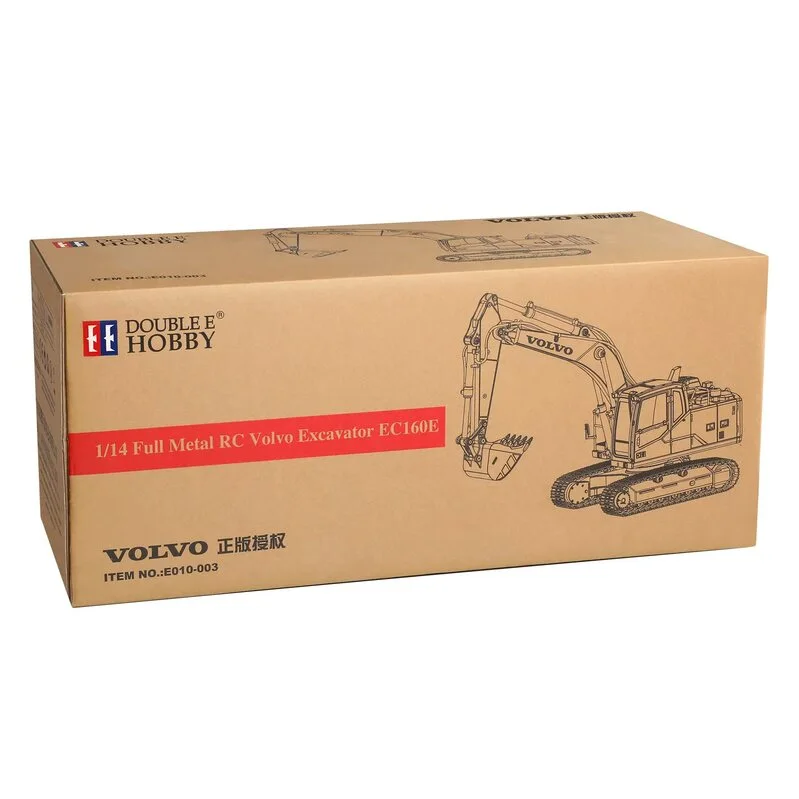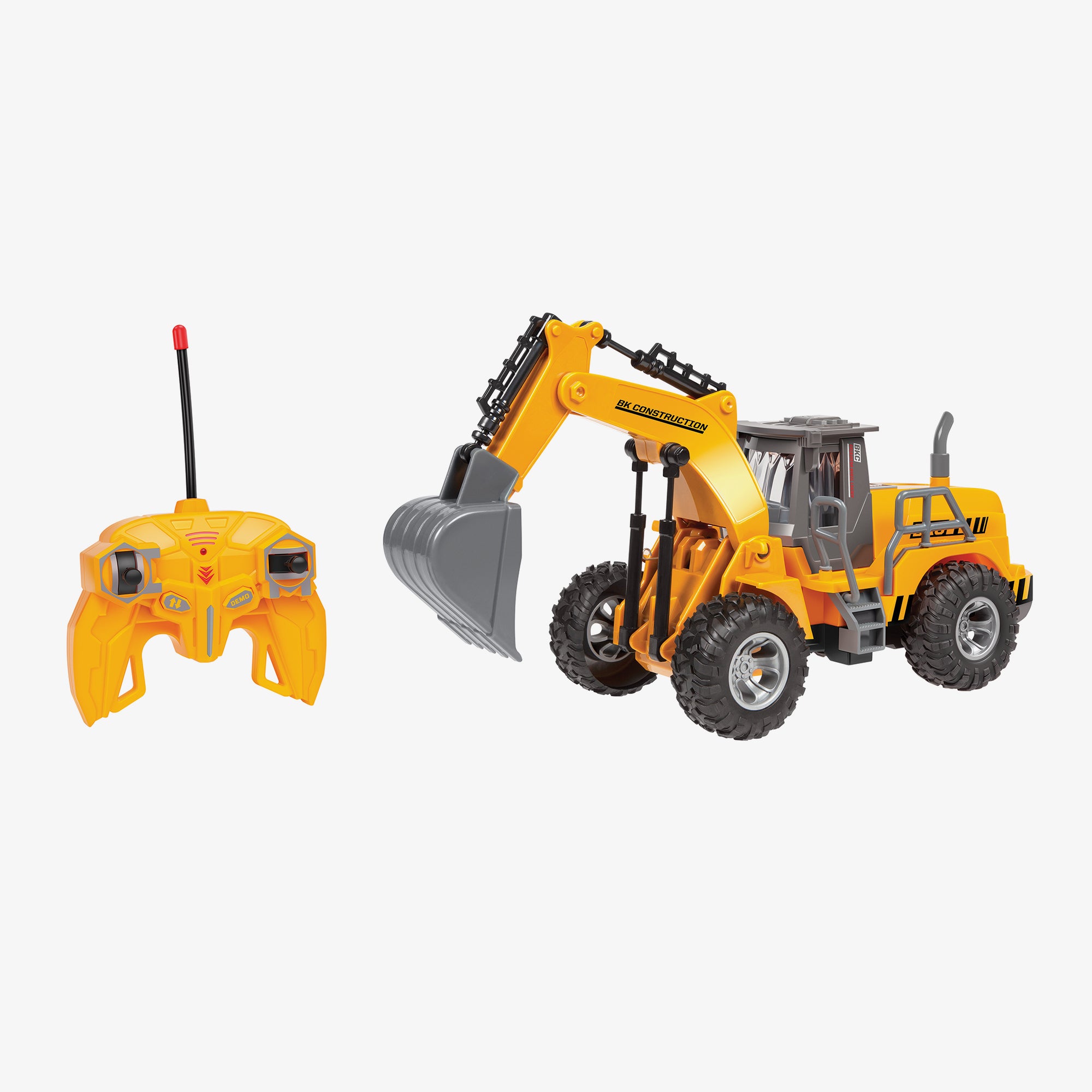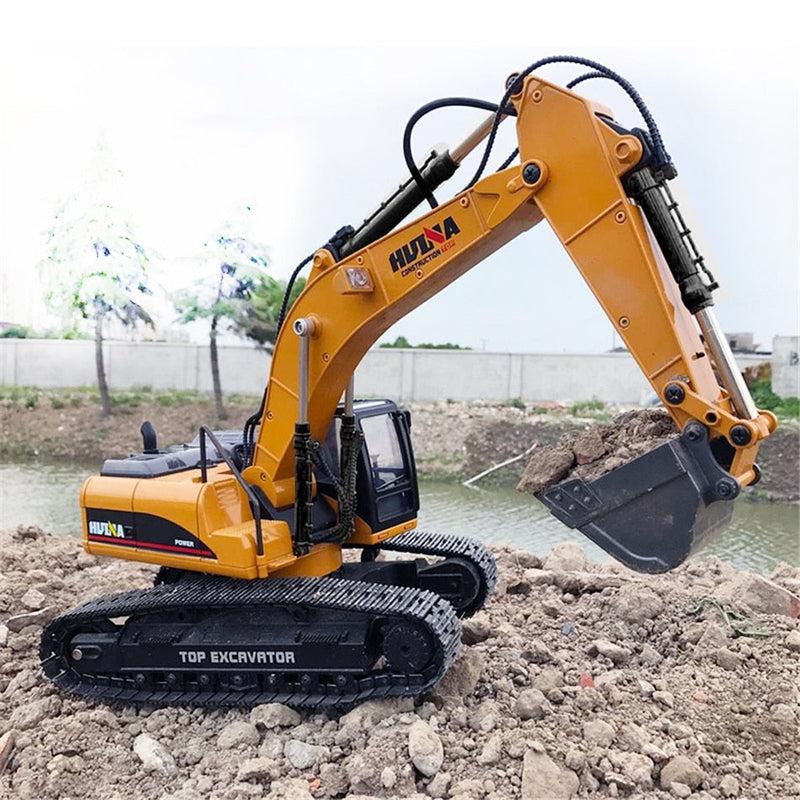The Top Benefits of Integrating a remote control excavator into Your Team
Wiki Article
The Necessary Attributes of Excavator That Make Things a Must-Have Tool
Excavators are vital in the construction and landscape design sectors. Their versatile accessories enable a variety of jobs, from excavating to demolition. Furthermore, they boast remarkable digging deepness and reach, powered by robust engines. Operator comfort and small styles boost use in various atmospheres. Nevertheless, what really establishes excavators apart are their innovative hydraulic systems and longevity. Comprehending these features can clear up why they are considered essential devices on any work website.Flexible Accessories for Improved Capability
Excavators are effective makers on their own, the addition of functional add-ons considerably boosts their capability. These attachments change a typical excavator right into a multi-purpose tool, suitable for a range of tasks. Containers, as an example, come in various sizes and shapes, making it possible for drivers to dig, scoop, and move materials successfully. Hydraulic thumbs can be included for improved gripping and handling of cumbersome things, such as logs or rocks.Furthermore, specialized add-ons like breakers and augers enable exploration and demolition job, broadening the excavator's utility on construction websites. remote control excavator. Grapples are an additional option, ideal for arranging and relocating particles. This flexibility not only raises efficiency but likewise reduces the demand for multiple equipments, saving time and expenses. By equipping excavators with the best add-ons, operators can take on diverse jobs, making them essential in the building and construction industrySuperior Digging Depth and Get To
Excavators are designed with remarkable digging depth and reach, permitting them to navigate in tight areas and gain access to hard-to-reach locations. This capability is vital for different building and construction and excavation projects, where standard equipment may fail. With adjustable boom arms and extendable tracks, excavators can conveniently browse irregular surface while keeping stability.The excavating depth can differ considerably amongst designs, usually ranging from 10 to 25 feet, depending upon the design and purpose. This function enables operators to excavate foundations, trenches, and various other deep frameworks efficiently. In addition, the reach of an excavator enables for exact excavating and product handling without rearranging the machine frequently, saving time and labor costs.Ultimately, the remarkable excavating deepness and reach of excavators make them crucial for specialists looking for to finish intricate jobs with accuracy and efficiency. Their versatility enhances efficiency on task sites, showcasing them as a necessary device in contemporary building.Powerful Engine Performance

When it pertains to performance and performance on building websites, effective engine efficiency plays a critical function in the capabilities of an excavator. A robust engine produces considerable horse power, enabling the machine to deal with durable jobs easily - remote control excavator. This strength converts right into faster cycle times, enabling operators to total projects extra quickly.Additionally, effective engines provide the essential torque to handle tough terrains and varied loads, making certain that the excavator can carry out efficiently under various problems. Whether it is raising, excavating, or moving products, the engine's performance directly influences the general functional effectiveness of the machine.Furthermore, innovations in engine technology have caused enhanced fuel performance, reducing operational prices while maintaining power outcome. Ultimately, the engine's performance works as the foundation of an excavator, verifying its condition as an essential tool in the construction market
Advanced Hydraulic Equipments

Boosted Raising Capability
A considerable enhancement in raising ability can be credited to sophisticated hydraulic systems discovered in contemporary excavators. These systems use high-pressure liquid to create better pressure, allowing operators to raise heavier lots easily. The design behind these hydraulics guarantees peak efficiency, supplying a remarkable power-to-weight ratio that improves general efficiency. As a result, excavators can take on demanding jobs, such as lifting large products or tools, without endangering security. Furthermore, the durable style of hydraulic components adds to boosted longevity and reliability, making them appropriate for different building environments. This boosted training ability not just minimizes the time needed for tasks yet additionally lessens the requirement for additional equipment, confirming vital for both productivity and cost-effectiveness in the construction industry.Boosted Precision Control
Conventional excavators typically battled with precision, contemporary hydraulic systems have actually changed control mechanisms, making it possible for drivers to implement jobs with remarkable accuracy. These advanced systems use symmetrical control valves that allow for smoother and much more responsive motions, considerably minimizing the margin for error. Operators can currently finely tune the excavator's motions, making it simpler to navigate limited rooms and manage fragile materials. Boosted feedback systems further notify drivers of real-time performance, making certain excellent coordination between the device and operator. This enhanced accuracy not only boosts efficiency however additionally improves safety on work websites, decreasing the threat of crashes. Therefore, contemporary excavators furnished with innovative hydraulic systems are important devices for building and excavation projects calling for thorough accuracy.Driver Comfort and Presence
Operator convenience and exposure are important components in the design of modern excavators (remote control excavator). Features such as ergonomic seat design, enhanced visibility alternatives, and effective control layouts greatly improve the operator's experience and productivity. Prioritizing these elements assurances that operators can function efficiently and safely in various conditionsErgonomic Seat Style
Comfort and visibility are critical in excavator design, with the ergonomic seat playing a necessary function in improving the operator's experience. An ergonomic seat is crafted to sustain the driver's body, lowering fatigue during lengthy hours of More Help procedure. Adjustable functions, such as seat height, backrest angle, and lumbar assistance, accommodate private choices and advertise excellent stance. These changes enhance comfort and make it possible for the operator to preserve concentrate on jobs without pain. In addition, a well-designed seat can supply far better lateral support, permitting for smoother handling when the excavator functions. This thoughtful design not just improves efficiency but likewise adds to general safety and security, making certain that operators can perform their tasks efficiently and efficiently.Improved Visibility Functions
The design of an excavator expands beyond just the seat, with boosted presence attributes playing a considerable role in driver comfort and overall safety. Huge home windows and strategically located mirrors offer drivers with a clear view of their environments, reducing blind areas. This style consideration enables for far better spatial recognition, which is vital in busy workplace. Additionally, many excavators integrate rearview cams and progressed tracking systems that aid operators in maneuvering limited spaces. The integration of these presence features not just advertises safety however also lowers operator fatigue by allowing much easier tracking of work locations. Ultimately, improved visibility contributes to a lot more reliable operations and aids ensure that excavators can perform their tasks successfully and safely.Control Layout Efficiency
While maneuvering complex job sites, a reliable control design significantly enhances both operator convenience and presence. A properly designed control setup assurances that operators can access vital features with marginal effort, minimizing fatigue throughout lengthy hours. Ergonomic joystick positionings and instinctive button arrangements enable for seamless procedure, allowing drivers to maintain concentrate on the job at hand. In addition, clear exposure of both the work area and the control panel is crucial for safety and security and accuracy. Modern excavators usually integrate flexible seats and control setups to suit numerous operator choices, additionally boosting comfort. Inevitably, a thoughtfully created control design not only enhances performance but likewise promotes a safer working site here atmosphere by permitting drivers to react swiftly to altering problems.Compact Style for Urban Environments
As city construction websites usually encounter room constraints, a compact style ends up being important for excavators operating in these atmospheres. These devices are engineered to browse tight areas, permitting for effective maneuverability in crowded task websites. A minimized footprint enables them to work closely to existing structures, decreasing interruption and making the most of productivity.The small layout often includes much shorter tracks and a tighter transforming distance, helping with procedure in slim alleys and constrained areas. Furthermore, light-weight materials add to alleviate of transport, making it less complex to move the excavator from one area to one more within the city landscape.Additionally, numerous compact excavators are furnished with features such as versatile accessories and extendable arms, enhancing their functionality while keeping a little size. This versatility permits drivers to tackle a variety of tasks, from digging to demolition, all while fitting flawlessly into the restraints of metropolitan settings.
Longevity and Maintenance Considerations
Toughness stands as a necessary variable in the efficiency and durability of excavators, specifically sought after urban environments. These equipments go through extensive conditions, including varying dirt types, extreme temperatures, and high-frequency use. Top quality products and durable construction are required for making certain that excavators can hold up against these obstacles without jeopardizing functionality.Regular maintenance is equally important in preserving sturdiness. Arranged examinations, timely oil adjustments, and the substitute of used elements contribute substantially to an excavator's lifespan. Operators should likewise pay attention to hydraulic systems, tracks, and undercarriages, as these components often bear the brunt of wear and tear.Investing in resilient excavators with extensive maintenance strategies boosts integrity and reduces downtime, inevitably bring about boosted productivity on building websites. Therefore, comprehending the interplay in between sturdiness and maintenance is vital for any person thinking about the procurement of an excavator for urban tasks.Regularly Asked Concerns
Just How Do Excavators Contrast to Various Other Building Tools?
Excavators stick out amongst construction equipment because of their versatility, enabling jobs such as grading, excavating, and training. Contrasted to others, their hydraulic capabilities offer higher efficiency and power, making them indispensable on various task sites.What Safety Features Are Consisted Of in Modern Excavators?
Modern excavators include different safety and security functions, consisting of rollover protection systems, alarm systems, and progressed presence improvements. These components function together to lessen risks, making certain operator safety while enhancing efficiency on construction websites and other requiring atmospheres.
Can Excavators Be Used in Wintertime Conditions?
Excavators can indeed be used in wintertime conditions, offered they are equipped with suitable winter attachments and preventative measures are taken. Correct upkeep and modifications improve their performance, ensuring reliable operation despite challenging climate scenarios.What Is the Ordinary Life-span of an Excavator?
The ordinary lifespan of an excavator commonly ranges from 7,000 to 10,000 hours of operation. This period can considerably depend on maintenance techniques, operating conditions, and the specific version's toughness and layout features.How Do I Pick the Right Excavator Size for My Task?
Choosing the ideal excavator dimension includes evaluating project range, site problems, and material types. Consider aspects like reach, deepness demands, and weight capacity to ensure maximum effectiveness and safety throughout operation. Dimension issues considerably in task success. Furthermore, the reach of an excavator permits for accurate digging and material handling without rearranging the equipment frequently, saving time and labor costs.Ultimately, the remarkable digging deepness and reach of excavators make them essential for specialists looking for to complete complex tasks with accuracy and efficiency. Comfort and presence are extremely important in excavator design, with site link the ergonomic seat playing a vital role in improving the driver's experience. The design of an excavator extends beyond simply the seat, with enhanced visibility attributes playing a considerable duty in operator comfort and total safety. Modern excavators usually include adjustable seats and control setups to suit different driver preferences, further boosting comfort. Light-weight products add to ease of transport, making it easier to move the excavator from one location to an additional within the metropolitan landscape.Additionally, lots of small excavators are equipped with functions such as functional add-ons and extendable arms, boosting their functionality while preserving a small size.Report this wiki page